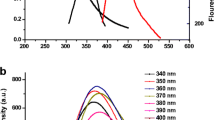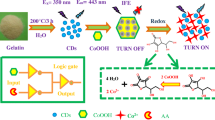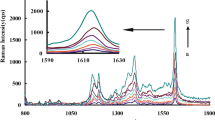Abstract
In this study, we propose a simple and versatile tri-modal (colorimetric, fluorometric, and electrochemical) means for detection of riboflavin using silver carbon dot (Ag@CD) nanoconjugates. Hydroxyl-rich carbon dot (CD) synthesized by microwave-assisted method using citric acid and PEG was used as reductant for Ag@CD formation. Effect of CD and AgNO3 concentration on Ag@CD synthesis was examined. Furthermore, we observed that the Ag@CD conjugates were capable of selectively detecting riboflavin. The sensing mechanism was based on aggregation of nanoconjugates as confirmed from scanning electron microscope micrographs. Red shifting of surface plasmon resonance peaks to around 550 nm concomitant with quenching and red shift of fluorescence peak was observed. Colorimetric assay showed a change in colour of assay mixture to red and detection limit of 2.5 µM was observed. In addition, electrochemical detection showed a high selectivity for riboflavin even in the presence of interfering analytes with a sensitivity of 1.56 µA/mM/cm2. This rationally designed tri-modal sensing platform offers simplicity of operation and faster detection which may be developed into a point-of-care diagnostic device.








Similar content being viewed by others
References
Bhaisare ML, Talib A, Khan MS, Pandey S, Wu H (2015) Synthesis of fluorescent carbon dots via microwave carbonization of citric acid in presence of tetraoctylammonium ion, and their application to cellular bioimaging. Microchim Acta. https://doi.org/10.1007/s00604-015-1541-5
Blau W, Ji W (2012) Feature issue introduction: nanocarbon for photonics and optoelectronics. Opt Mater Express 2(6):891–892
Collings PJ, Gibbs EJ, Starr TE, Vafek O, Yee C, Pomerance LA, Pasternack RF (1999) Resonance light scattering and its application in determining the size, shape, and aggregation number for supramolecular assemblies of chromophores. J Phys Chem B 103:8474
Cooperman JM (1991) Lopez R. Handbook of Vitamins, New York, pp 283–310
Cumming RG, Mitchell P, Smith W (2000) Diet and cataract: the blue mountains eye study. Ophthalmology 107(3):450–456
Foraker AB, Khantwal CM, Swaan PW (2003) Current perspectives on the cellular uptake and trafficking of riboflavin. Adv Drug Deliv Rev 55:1467
Hilgenbrink AR, Low PS (2005) Folate receptor-mediated drug targeting: from therapeutics to diagnostics. J Pharm Sci 94:2135
Jiang XY, Chen XQ, Dong Z, Xu M (2007) The application of resonance light scattering technique for the determination of tinidazole in drugs. J Automat Methods Manage Chem. https://doi.org/10.1155/2007/8685710.1155/2007/86857
**** QM, Sufang S, Meifang Z, Yong W, Dong GC (2016) Colorimetric detection of riboflavin by silver nanoparticles capped with β cyclodextrin-grafted citrate. Coll Surf B 10:11. https://doi.org/10.1016/j.colsurfb.2016.08.040
Joshi N, Rawat K, Solanki PR, Bohidar HB (2015a) Enzyme-free and biocompatible nanocomposite based cholesterol sensor. Biochem Eng J 102:69
Joshi N, Rawat K, Solanki PR, Bohidar HB (2015b) Biocompatible laponite ionogels based non-enzymatic oxalic acid sensor. Sens Bio-Sens Res 5:105
Kumar V, Lockerbie O, Keil SD, Ruane PH, Platz MS, Martin CB et al (2004) Riboflavin and UV-light based pathogen reduction extent and consequence of DNA damage at the molecular level. Photochem Photobio 80:15
Liu R, Wu D, Liu S, Koynov K, Knoll W, Li Q (2009) An aqueous route to multicolor photoluminescent carbon dots using silica spheres as carriers. Angew Chem 121:4668
Lorent-Martinez EJ, Garcia-Reyes JF, Ortega-Barrales P, Molina- Diaz A (2006) A multicommuted fluorescence-based sensing system for simultaneous determination of vitamins B2 and B6. Anal Chim Acta 555:128
Lu Q, Deng J, Hou Y, Wang H, Li H, Zhang Y, Yao S (2015a) Hydroxyl-rich C-dots synthesized by a one-pot method and their application in the preparation of noble metal nanoparticles. Chem Commun 51:7164
Lu Q, Liu Y, Hou Y, Wang H, Zhang Y, Yao S (2015b) Detection of thiocyanate through limiting growth of AuNPs with C-dots acting as reductant. Analyst 140:7645
Luo P, Chun L, Shi G (2012) Synthesis of gold@ carbon dots composite nanoparticles for surface enhanced Raman scattering. Phys Chem Chem Phys 14:7360
Mandal SM, Mandal M, Ghosh AK, Dey S (2009) Rapid determination of vitamin B2 and B12 in human urine by isocratic liquid chromatography. Anal Chim Acta 640:110
Modi RP, Mehta VN, Kailasa SK (2014) Bifunctionalization of silver nanoparticles with 6-mercaptonicotinic acid and melamine for simultaneous colorimetric sensing of Cr3+ and Ba2+ ions. Sens Actuators B 195:562
Montet X, Funovics M, Montet-Abou K, Weissleder R, Josephson L (2006) Multivalent effects of RGD peptides obtained by nanoparticle display. J Med Chem 49:6087
Perez-Ruiz T, Martinez-Lazazo C, Tomas V, Val O (1994) Photochemical spectrophotometric determination of riboflavin and riboflavin 5′-phosphate by manual and flow injection methods. Analyst 119:1199
Prakash P, Gnanaprakasam P, Emmanuel R, Arokiyaraj S, Saravanan M (2013) Green synthesis of silver nanoparticles from leaf extract of Mimusops elengi, Linn. for enhanced antibacterial activity against multi drug resistant clinical isolates. Coll Surf 108:255–259
Priyadarshini E, Rawat K (2017) Au@carbon dot nanoconjugates as dual mode enzyme-free sensing platform for Cholesterol. J Mater Chem B 5:5425
Schoenen J, Jaequy J, Lenaerts M (1998) Effectiveness of high-dose riboflavin in migraine prophylaxis. A randomized controlled trial. Neurology 50:466–470
Shukla R, Thomas TP, Desai A, Kotlyar A, Park SJ, Baker JR (2008) HER2 specific delivery of methotrexate by dendrimer conjugated anti-HER2 mAb. Nanotechnology 19:295102
Silberstein SD, Goadsby PJ, Lipton RB (2000) Management of migraine: al algorithmic approach. Neurology 55:46–52
Silverstin RM, Webster FX (1998) Spectrometric identification of organic compounds, university of Michigan, Ann Arbor, Mich, USA, 6th edn. Wiley, New York
Tetgure SR, Borse AU, Sankapal BR, Garole VJ, Garole DJ (2015) Green biochemistry approach for synthesis of silver and gold nanoparticles using Ficus racemosa latex and their pH-dependent binding study with different amino acids using UV/Vis absorption spectroscopy. Amino Acids 47:757
Toebes ML, Dillen JA, Jong KP (2001) Synthesis of supported palladium catalysts. J Mol Catal A: Chem 173:75
Unna K, Greslin JG (1942) Studies on the toxicity and pharmacology of riboflavin. J Pharmacol Exp Ther 76:75–80
Vilela D, Gonzalez MC, Escarpa A (2012) Sensing colorimetric approaches based on gold and silver nanoparticles aggregation: chemical creativity behind the assay. A review. Anal Chim Acta 751:24
Vinas P, Balsalobre N, Lopez-Erroz C, Hernadez-Cordoba M (2004) Liquid chromatographic analysis of riboflavin vitamers in foods using fluorescence detection. J Agric Food Chem 52:1789
Wang B, Zhang Z, Chang K, Cui Jm Rosenkranz A, Yu J, Lin C, Chen G, Zang K, Luo J, Jiang N, Guo D (2018) New deformation-induced nanostructure in silicon. Nano Lett 18(7):4611–4617. https://doi.org/10.1021/acs.nanolett.8b01910
White HB, Merrill AH (1988) Riboflavin-binding proteins. Annu Rev Nutri 8:279
Wildgoose GG, Banks CE, Compton RG (2006) Metal nanoparticles and related materials supported on carbon nanotubes: methods and applications. Small 2:182
Yang ST, Cao L, Luo PG, Lu F, Wang X, Wang H, Meziani MJ, Liu Y, Qi G, Sun YP (2009) Carbon dots for optical imaging in vivo. J Am Chem Soc 131:11308
Zhang CX, Qi HL (2002) Highly sensitive determination of riboflavin based on the enhanced electrogenerated chemiluminescence of lucigenin at a platinum electrode in a neutral aqueous solution. Anal Sci 18:819
Zhang Z, Song Y, Xu C, Guo D (2012) A novel model for undeformed nanometer chips of soft-brittle HgCdTe films induced by ultrafine diamond grits. Scripta Mater 67(2):197–200
Zhang Z, Guo D, Bo Wang, Kang R, Zhang B (2015a) A novel approach of high speed scratching on silicon wafers at nanoscale depths of cut. Sci Rep 5:16395
Zhang Z, Wang B, Kang R, Zhang B, Guo D (2015b) Changes in surface layer of silicon wafers from diamond scratching. CIRP Ann 64(1):349–352
Zhang Z, Huang S, Chen L, Wang B, Wen B, Zhang B, Guo D (2017a) Ultrahigh hardness on a face-centered cubic metal. Appl Surf Sci 416:891–900
Zhang Z, Cui J, Wang B, Wang Z, Kang R, Guo D (2017b) A novel approach of mechanical chemical grinding. J Alloy Compd 726:514–524
Zhang Z, Shi Z, Du Y, Yu Z, Guo L, Guo D (2018) A novel approach of chemical mechanical polishing for a titanium alloy using an environment-friendly slurry. Appl Surf Sci 427:409–415
Zhang Z, Cui J, Zhang J, Liu D, Yu Z, Guo D (2019) Environment friendly chemical mechanical polishing of copper. Appl Surf Sci 467:5–11
Zhao D, Chen C, Sun J, Yang X (2016) Carbon dots-assisted colorimetric and fluorometric dual-mode protocol for acetylcholinesterase activity and inhibitors screening based on the inner filter effect of silver nanoparticles. Analyst. https://doi.org/10.1039/c6an00514d
Zhenyu Z, Yan**a H, DongMing G (2013) A model for nanogrinding based on direct evidence of ground chips of silicon wafers. Sci China-Technol Sci 56(9):2099–2108
Acknowledgements
EP is thankful to DST for fellowship under DST-SERB NPDF fellowship (Grant number PDF/2017/000024). This research was supported by a DST-PURSE-II funding. The authors thank the Advanced Instrument Research Facility of the University for SEM facility.
Author information
Authors and Affiliations
Corresponding author
Ethics declarations
Conflict of interest
The authors declare that they have no conflict of interest.
Additional information
Publisher’s Note
Springer Nature remains neutral with regard to jurisdictional claims in published maps and institutional affiliations.
Electronic supplementary material
Below is the link to the electronic supplementary material.
Rights and permissions
About this article
Cite this article
Priyadarshini, E., Rawat, K. & Bohidar, H.B. Multimode sensing of riboflavin via Ag@carbon dot conjugates. Appl Nanosci 10, 281–291 (2020). https://doi.org/10.1007/s13204-019-01090-6
Received:
Accepted:
Published:
Issue Date:
DOI: https://doi.org/10.1007/s13204-019-01090-6




